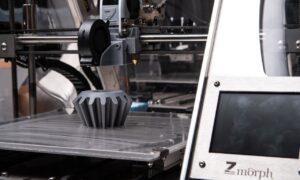Welcome to the world of 3D printing, where imagination meets reality! This groundbreaking technology has taken innovation to new heights, revolutionizing industries and sparking a creative fire within individuals worldwide. Are you ready to dive into the limitless possibilities and unleash your inner inventor? Look no further! In this comprehensive guide, we will unravel the secrets behind 3D printing, exploring its incredible potential and shedding light on how it reshapes our future. So fasten your seatbelts, because we’re about to embark on an extraordinary journey filled with awe-inspiring creations and mind-boggling advancements. Get ready to witness the power of 3D printing like never before.
What is 3D Printing?
3D printing is an additive manufacturing technology that creates three-dimensional objects by successively adding material layer by layer. It is also known as additive manufacturing or rapid prototyping. Unlike traditional manufacturing processes that use subtractive techniques to remove material from a workpiece (such as machining), 3D printing builds objects by depositing materials one layer at a time according to a digital model.
This guide will explore the history, applications, and benefits of 3D printing technology.
Benefits of 3D Printing Techngoloy
3D printing technology offers a wide range of benefits to businesses and individuals alike. Perhaps the most significant benefit is its ability to facilitate rapid prototyping. In the past, creating a prototype could take weeks or even months, but with 3D printing, it can be done in hours or days. This not only saves time and money, but it also allows businesses to get their products to market faster.
Another benefit of 3D printing technology is that it enables businesses to customize their products. This means that they can create products that are specifically designed to meet the needs of their target market. This level of customization is not possible with traditional manufacturing methods.
Finally, 3D printing technology is also environmentally friendly. It doesn’t produce any harmful emissions and uses less energy than traditional manufacturing methods.
Types of 3D Printing Technologies
3D printing technology has come a long way since it was first introduced in the 1980s. Today, there are many different types of 3D printing technologies available, each with its own unique set of capabilities and applications.
The most common type of 3D printing technology is called fused deposition modeling (FDM). FDM works by extruding a thin layer of melted plastic onto a build platform. The printer then builds up the object one layer at a time until it is complete.
Another popular type of 3D printing technology is called stereolithography (SLA). SLA works by curing a photosensitive resin with an ultraviolet (UV) laser. The UV laser draws the shape of the object layer by layer, and the cured resin hardens to form the finished product.
There are also many other types of 3D printing technologies available, including selective laser sintering (SLS), polyjetting, and multi-material jetting. Each of these technologies has its own advantages and disadvantages, and it’s important to choose the right one for your specific application.
Industrial Applications of 3D Printing
3D printing technology has been around for decades, but it has only recently begun to be used in industrial applications. One of the most promising applications for 3D printing is in the area of custom manufacturing. With 3D printing, manufacturers can create customized parts and products quickly and easily. This is particularly beneficial for businesses that need to produce short runs of custom products or that need to make prototypes quickly and cheaply.
Another potential application for 3D printing is in the area of mass production. In theory, 3D printers could be used to mass-produce products quickly and efficiently. However, this technology is still in its early stages and has not yet been perfected. Nonetheless, some companies are already using 3D printers to mass-produce small items such as jewelry and eyeglass frames.
Yet another possible industrial application for 3D printing is in the area of food production. In recent years, there have been a number of companies that have developed 3D printers that can print food. These printers are still in their infancy, but they hold great promise for future food production. Additionally, these printers could be used to create customized meals for people with specific dietary needs.
There are many potential industrial applications for 3D printing technology. This technology is still in its early stages, but it has great potential to revolutionize manufacturing and other industries.
Home Applications of 3D Printing
3D printing technology has been around for decades, but it has only recently become widely available for home use. Though still in its infancy, 3D printing has great potential for revolutionizing the way we live and work. Here are some of the ways 3D printing could be used in the home:
– Customized prosthetics and other medical devices: With 3D printing, it is possible to create customized prosthetics and other medical devices that perfectly fit the patient’s body. This could greatly improve the quality of life for those with disabilities.
– Personalized jewelry: Imagine being able to design your own jewelry and have it printed out in minutes! With 3D printing, this is now possible.
– Home decor: Want a one-of-a-kind piece of art for your home? Or perhaps you need a replacement part for a broken item? 3D printing can help you with both of these things and more.
– Educational toys and models: Kids can learn best by playing and exploring. 3D printed toys and models can help make learning more fun and interactive.
Safety Guidelines for Working with 3D Printers
Working with 3D printers can be dangerous if proper safety guidelines are not followed. Here are some safety guidelines to follow when working with 3D printers:
• Always wear protective gear when working with 3D printers. This includes gloves, goggles, and a respirator.
• Be aware of your surroundings and make sure that there is adequate ventilation when working with 3D printers.
• Never leave a 3D printer unattended while it is in use.
• Keep flammable materials away from 3D printers.
• Do not touch hot surfaces on 3D printers. Allow them to cool down before handling.
Cost Factors of 3D Printing
3D printing is an additive manufacturing technology that creates three-dimensional objects by successively adding material layer by layer. The cost of 3D printing depends on a variety of factors, including the type of printer, the price of materials, and the size and complexity of the object being printed.
The type of printer is one of the most important factors in determining the cost of 3D printing. There are a variety of different types of 3D printers available on the market, each with its own advantages and disadvantages. The most common type of 3D printer is the fused deposition modeling (FDM) printer, which uses melted plastic filament to create objects layer by layer. FDM printers are typically less expensive than other types of 3D printers, but they have some limitations in terms of the materials that can be used and the quality of the final product.
The price of materials is another important factor to consider when calculating the cost of 3D printing. A variety of different materials can be used for 3D printing, including plastics, metals, ceramics, and even human tissue. Each material has its own unique properties and costs associated with it. In general, plastics are the cheapest materials to use for 3D printing, while metals are usually more expensive.
The size and complexity of the object being printed also play a role in determining the cost of 3D printing. Smaller and simpler objects can be printed more quickly and cheaply than larger and more complex objects. Additionally , the time required to print an object can also affect the cost of 3D printing. Objects that take longer to print are generally more expensive.
Future Outlooks for the Industry
It is estimated that the 3D printing industry will be worth $32.78 billion by 2025. This rapid growth is due to the ever-increasing adoption of 3D printing technology across a range of industries, from healthcare to aerospace.
As the technology continues to develop, it is expected that 3D printing will become more widespread and accessible. This will open up new opportunities for businesses and individuals to create innovative products and solutions.
There are a number of factors that will contribute to the continued growth of the 3D printing industry. These include the decreasing cost of 3D printers, the increasing availability of 3D printing materials, and the improvement of 3D printing technology.
Conclusion
We hope that our comprehensive guide to 3D printing has opened your eyes to the power of this technology and its potential applications. From medical procedures to manufacturing, 3D printing is revolutionizing industries across the world and creating amazing opportunities for entrepreneurs. If you’re interested in exploring what 3D printing can do for your business, make sure you get the right printer for your needs and start experimenting with different materials – who knows where it might take you?



































